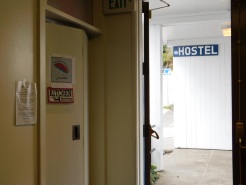
Submitted by Pastor Janice Carlton, First UMC of Ketchikan
The First United Methodist Church of Ketchikan, Alaska is located on Revillagigedo Island in a rainforest with a population of a little over 8,000. There has been a Methodist presence since 1901 when the town was a small mining and fishing village. It has the distinction of being the first completed church building in the first incorporated town in Alaska. Ketchikan is a town of two seasons. Even though there is only one main road 34 miles long, the differences between these seasons are extreme in population and activities. Between May and October the population walking its streets in a day can more than double its year round daily population. A tourist disembarking from one of the many cruise ships could easily encounter the missions of the church.
Since the church is located in the historic downtown section it is affected by both on and off-season activities. Three months of the year it hosts people from all over the world in its hostel. The hostel was begun in the 1960s to provide an affordable place to stay while touring the town. It is currently located in the second floor of the church. For $20 a night visitors arriving by plane and ferry can have a safe, clean place to sleep. The guests also have access to a full kitchen and showers. This year the hostel has also been home to several local people. While working seasonal jobs they have affordable housing and amenities. The hostel is staffed by volunteers assigned by the General Board of Global Ministries (GBGM). These volunteers are “faces” for the hostel and their willingness to serve and witness are gifts to all the lives they touch. During the remainder of the year the hostel beds are used by visiting middle and high school students. Traveling teams or groups can stay in the church when competing against or performing with the local school teams and music groups.

The hostel is not the only “safe sanctuary” offered by this church. First City Homeless Shelter and, more recently, the fall and winter Ketchikan Warming Center are located in the basement/fellowship hall of the church. The planning for this shelter began in 1987 during the appointment of Reverend Bob Bowers and came to fruition during the appointments of Evelyn and Teri Erberly. Year-round from 8 AM to 4 PM the basement is open to the homeless and anyone needing a warm, dry place to “hang out.” A light breakfast is available with hot coffee throughout the day and showers and clean clothes are available. Guests utilizing this facility may also receive tutoring on computer skills and job searching.
In the fall and winter the homeless shelter hours extend to include the Ketchikan Warming Center. In addition to the day shelter, a Warming Shelter is open from 8 PM to 6 AM. During these hours, once again, a warm, dry place is available including an evening meal.
One of the first things a tourist will notice as they wander uphill on Grant Street from the docks is the Easter totem attached to the corner of the church. Ketchikan is a town with many totems. This storytelling tradition was used by indigenous peoples to preserve history and stories big and small.

Reverend David Fison (appointed to Ketchikan from 1961-1966) embraced this tradition and carved two Christian totems. One explained the Christmas story and the other Easter. In true missionary tradition he spread the “Good News” by incorporating “language” familiar to his listeners.
These two seasons could be named the Tourist Season and the Season of Daily Living in a Small Community.
The First United Methodist Church is a church for both.. The question is often asked, “If the doors of your church were closed would the community notice?” The answer to that question for this church is YES.
Community is a corner stone for this UMC church. It has a passion for locally-based community mission. The church participates in community worship opportunities such as the Sunrise Service and Blessing of the Fleet. It follows Jesus’ request to “Feed my Sheep” by providing meals for 40 to 70 men, women, and children in the communities’ Soup Kitchen and Lord’s Table. The joy of small town living is celebrated in the church parking lot during the “Blueberry Festival” (this year was the 44th). During this festival the church has a food stand which includes selling blueberry pies with several “secret ingredients.” The First United Methodist Church is also a partner with “Love in Action.” Through this organization people are shown the love of Christ receiving help with food and utilities during the rough seasons of their life. For the last year this church and Ketchikan Presbyterian church have shared a pastor and several worship opportunities including a choir.
The First United Methodist Church hears and lives John 21:16-17.
“When they had finished eating, Jesus said to Simon Peter son of John, do you love me more than these?” “Yes, LORD,” he said, “you know that I love you.” Jesus said, “Feed my lambs.” Again Jesus said, “Simon son of John, do you love me?” He answered, “Yes, LORD, you know that I love you.” Jesus said, “Take care of my sheep.” The third time he said to him, “Simon son of John, do you love me?” Peter was hurt because Jesus asked him the third time, “Do you love me?” He said, “LORD, you know all things; you know that I love you.” Jesus said, “Feed my sheep.
Thank you to Evelyn Valentine (her written history of the church was essential), Roland and Alaire Stanton, and Kathy Early for their help.


